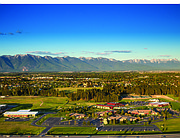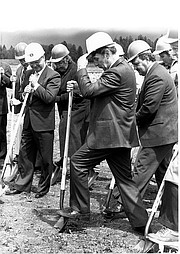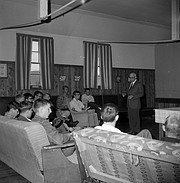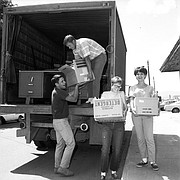'Visionary' civic leaders set the stage for FVCC
In 1967, three people sat around a table in the top floor of the Kalispell Public Library with a typewriter between them and a bullet-point plan to create a community college.
“We knew we needed a course catalog, instructors, students ... places to teach,” said Bill McClaren, the first dean of students at Flathead Valley Community College.
On April 1, a voter-approved ballot initiative established the college with a 3,013 to 2,308 vote.
Seven years before that election day, McClaren had stood before the Kalispell public schools’ Board of Trustees and announced that just 20 percent of Flathead County high school graduates were then seeking higher education.
From the time McClaren presented his study to the board in 1960 through the county election in 1967, a handful of Flathead County residents worked to define what shape higher education should take in the valley — and to sell that vision to voters.
OWEN Sowerwine was the chairman of the Flathead County High School board who became the voice behind the megaphone for establishing a local community college.
According to a Dec. 11, 1966, Daily Inter Lake article, Sowerwine told audience members at a Whitefish Rotary Club meeting that Flathead County was an “ideal area to establish a community college” because its population ranked fifth in the state.
“Community colleges and junior colleges are being ignored as the solution to vocational education of those young people who find it impossible to get a formal education in our universities,” Sowerwine said.
When the college’s first employees meet the day after their task was certain on April 2, 1967, they began calling local businesses with the plea for classes to be housed in any building where there was space.
The college’s first building in 1967 was the former Great Northern train depot in downtown Kalispell, now the Kalispell Chamber of Commerce, which housed the administrative and faculty offices. Forestry and surveying classes were held at the fairgrounds. Shop classes were held at the high school. Other buildings downtown, including the old Elks Building, were incorporated into the hodgepodge campus. In 1969, science labs, student services, the student paper and basic education courses were located in the historic Central School between First and Second streets.
Over the next two decades, as enrollment grew, so did FVCC’s presence and importance in downtown Kalispell.
IN ITS first year, FVCC offered 23 courses to 611 students taught by nine faculty members. Courses ranged from art to zoology. Many of the college’s students went on to collect four-year degrees from the University of Montana and Montana State University as well as numerous other colleges. Others used their two-year degree to get employment here in the valley.
By 1969, the college had 1,327 students and 30 faculty, according to an article by the student newspaper, Mnemosyne, which was then published in the Daily Inter Lake. The college’s first president, Larry Blake, told the student paper the college had expanded its programs by 40 percent.
“Also, we have enlarged our program in the extracurricular areas, recognizing the need to educate the total student — socially, physically, as well as intellectually,” Blake said.
One of those areas was the college’s drama program.
Ron Danko arrived on campus in 1969 as the school’s drama coach. Since its creation, the school’s theater program has acted as a platform for students to honor the classics as well as push the limits. Danko’s free-wheeling approach inspired his students, including future TV and movie star Troy Evans, and made the theater a central part of the old campus. By 1981, when the department produced “The Sound of Music,” more than 2,000 people attended the show’s 14 sold-out performances. A few years later, the college’s production of “Veronica’s Room” drew attention after word spread that it included profanity and risque scenes.
The same year the school’s drama program began, the FVCC Mountaineers basketball team graduated from a county league to becoming a regional powerhouse. When the new team, featuring recruited players from around the country, played its first basketball game in the Flathead High School gym, more than 1,000 people sat in the audience. While the basketball program ended after its first season, the names of its early coaches and players are still recognized in the valley.
In 1970, the college debuted its track, cross-country, golf and tennis teams, many of which performed at the highest caliber.
Two years later, FVCC established a logger sports program to honor the state’s forestry and logging history. As of 2016, the FVCC Stumpjumpers had won 14 first-place trophies at the largest logger sports event in the Northwest, the Association of Western Forestry Clubs Conclave.
In 1979, the college expanded its reach with a department dedicated to non-credit classes for people who wanted to continue their education without the goal of working toward a degree.
What began as outreach centers located in local libraries and public schools has grown into the Continuing Education Center. Last year, the center offered 432 classes and served more than 3,500 people.
ON MAY 23, 1989, FVCC leaders walked through an empty field off U.S. 93 north of Kalispell. They wore business suits, white construction hats and carried shovels as they made their way to break ground for a new campus that would allow the college to abandon its dilapidated and scattered downtown quarters.
At the time, the campus blueprint called for three buildings.
Today, the campus has eight buildings including an early childhood center. That number does not include FVCC property off the main campus. The college’s first on-campus student housing is set to open to students in time for the upcoming fall semester.
FVCC President Jane Karas said in a recent interview that the people who pushed for the college’s creation altered the layout of the valley.
“They were visionary people who knew there was a need in Northwest Montana,” Karas said. “They all knew what education could do to transform not just individuals, but their family and this region.”
The college has continued to expand its footprint in Northwest Montana.
FVCC created Montana’s first college brewing science program in 2015 after local breweries and hops growers voiced a need for more trained employees.
After students asked for more fields in technology, the college designed a degree around programming and game design, set to begin this fall.
When Weyerhaeuser — one of Columbia Falls’ largest employers — announced last year it was closing its sawmill and plywood plant, FVCC administrators and advisers arrived at the mill with pamphlets in-hand for college scholarships, degrees, certificates and courses that could lead to new employment.
Karas said the many roles the college plays in the community were part of its creators’ vision.
“And we’ll continue to grow and work in partnership with the community, local businesses and industries as workforce needs continue to grow,” Karas said. “It’s been a wonderful relationship so far — everybody in Northwest Montana should be taking some credit for this college.”
Reporter Katheryn Houghton may be reached at 758-4436 or by email at khoughton@dailyinterlake.com.










